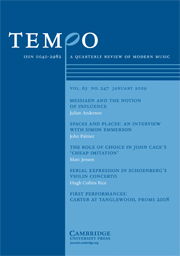Refine listing
Actions for selected content:
Contents
Research Article
MESSIAEN AND THE NOTION OF INFLUENCE
-
- Published online by Cambridge University Press:
- 29 January 2009, pp. 2-18
-
- Article
- Export citation
SPACES AND PLACES: AN INTERVIEW WITH SIMON EMMERSON
-
- Published online by Cambridge University Press:
- 29 January 2009, pp. 19-23
-
- Article
- Export citation
THE ROLE OF CHOICE IN JOHN CAGE'S ‘CHEAP IMITATION’
-
- Published online by Cambridge University Press:
- 29 January 2009, pp. 25-37
-
- Article
- Export citation
SERIAL EXPRESSION IN SCHOENBERG'S VIOLIN CONCERTO, OP. 36
-
- Published online by Cambridge University Press:
- 29 January 2009, pp. 38-44
-
- Article
- Export citation
First Performances
FIRST PERFORMANCES
-
- Published online by Cambridge University Press:
- 29 January 2009, pp. 46-69
-
- Article
- Export citation
Book Review
Book Reviews
-
- Published online by Cambridge University Press:
- 29 January 2009, pp. 70-72
-
- Article
- Export citation
CD Reviews
CD REVIEWS
-
- Published online by Cambridge University Press:
- 29 January 2009, pp. 73-91
-
- Article
- Export citation
News Section
NEWS SECTION
-
- Published online by Cambridge University Press:
- 29 January 2009, pp. 92-96
-
- Article
-
- You have access
- Export citation
Front matter
TEM volume 63 issue 247 Cover and Front matter
-
- Published online by Cambridge University Press:
- 29 January 2009, pp. f1-f2
-
- Article
-
- You have access
- Export citation
Back matter
TEM volume 63 issue 247 Cover and Back matter
-
- Published online by Cambridge University Press:
- 29 January 2009, p. b1
-
- Article
-
- You have access
- Export citation
